Common hazel and its cultivation

Common hazel, in Latin Corylus avellana, is called a hazel or wild hazelnut, which occurs naturally in the form of deciduous shrubs or trees. The plant belongs to the family Birch (Betulaceae) from the genus Hazel (Corylus).
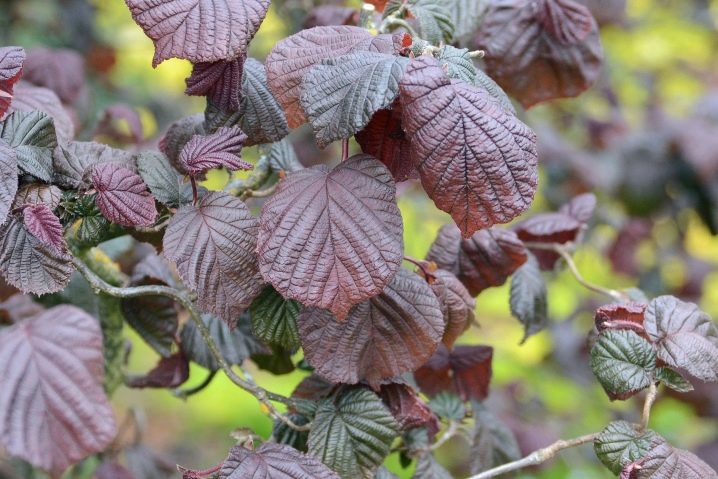
Description
The area of distribution of culture in the wild is very wide. This is the Caucasus, all of Europe, the Middle East - Bahrain, Kuwait, Jordan and other territories. Hazel is found even in such a northern country as Norway, and in its polar region, where hazel grows in the Prestegordskogen reserve and even a little north of it. In the Russian Federation, the culture is widespread in European forest, forest-steppe and steppe zones.
For the most part, hazel is found in coniferous, deciduous and mixed forests, where it looks like a low underbrush. The hazel grove can only unfold in full force in freedom, for example, in clearings, forest edges, or in the steppes. In addition, hazel loves to settle in fires or empty clearings - where hazel has no competitors, it grows in a lush cover, sometimes completely blocking the path of rivals for living space.
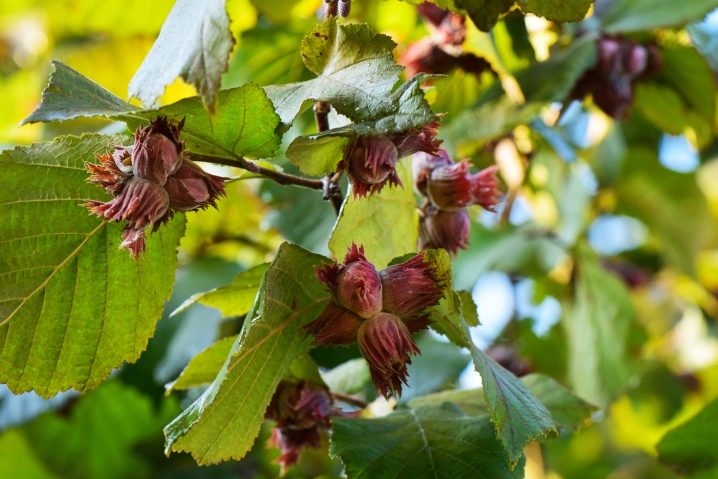
It is often found on the banks of water bodies, in gullies and on the slopes of hills. On the mountain slopes, wild hazelnuts settle down to the borders of forest zones. One of the features of hazel, because of which it can be safely called an aggressor, is the tendency to powerful procreation of root suckers. Root shoots have extraordinary vitality and allow the crop to quickly reclaim neighboring areas.
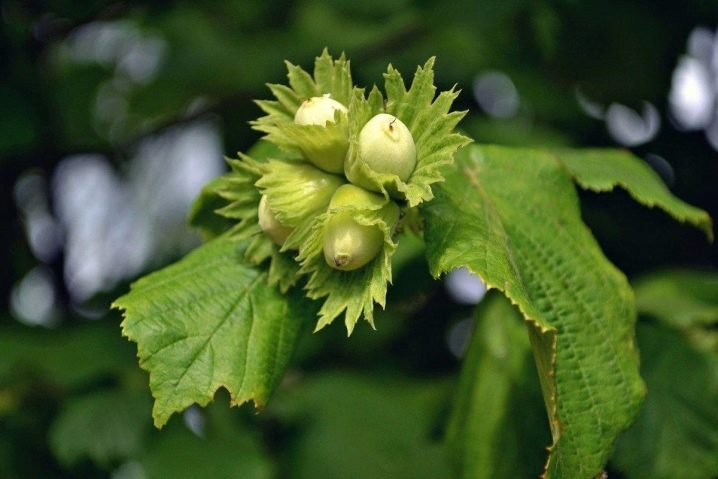
Botanical description.
-
Life form - deciduous shrub, crown diameter 5-6 meters... The average height of the shrub varies from 2 to 5 meters, but hazel trees up to 7 meters can be found. Treelike hazel can grow up to 30 meters in height. The bark on the trunk has a brownish-gray tint, a smooth surface and clearly visible transverse stripes. The skin of the shoots is painted in brownish-gray tones, the surface has a weak glandular-hairy pubescence. The powerful root system is superficial.
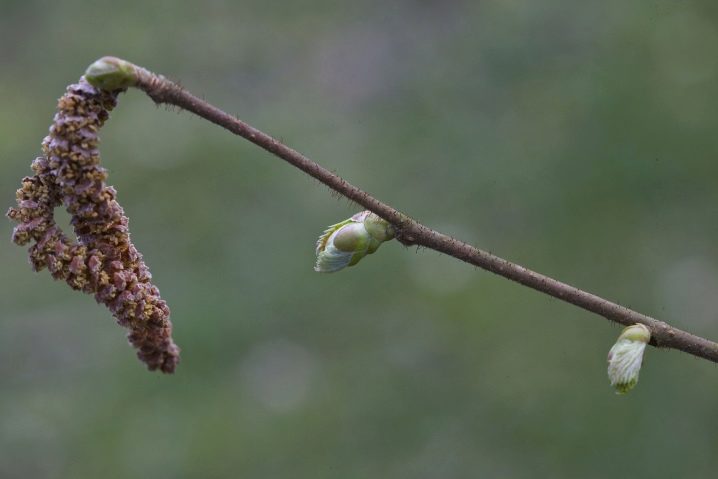
- The leaf arrangement is next. The surface of the large, rounded obovate foliage has a matte velvety texture. The length of the leaf plate varies from 6 to 12, the width is from 5 to 9 cm. The ends of the dark green leaves are pointed, sometimes the leaf has a truncated shape with a heart-shaped base and a "planted" point. The border of the leaf is indented with irregular double truncated teeth, turning into large lobed teeth in the upper part. The leaves sit on glandular-bristly petioles from 0.7 to 1.7 cm. The inflorescence is a yellow earring.

-
Crowded (2-5 pcs.) Hazel fruits Are single-seeded ball nuts with a thin, but dense shell, "wrapped" in a fruity light green velvety goblet or bell-shaped plyus formed by overgrown bracts. Parameters of light brown or dark brown nuts: length - 1.8 cm, diameter - 1.3-1.5 cm. The crop bears fruit in August-September, sometimes harvesting begins in late July. Productivity - 900 kg per 1 hectare, the number of fruits in 1 kg - about 900 pieces or slightly less. Fruiting occurs rather late: at 5-10 years of age.
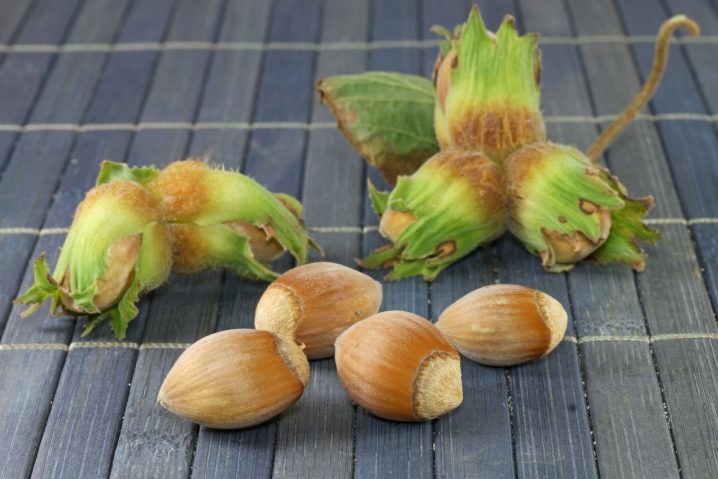
Flower formula in hazel: h (5) l1 + 2 + m2 (9) + 1n1. Common hazel is a frost-resistant crop that can withstand temperatures as low as -40ºC.The vital activity of the plant is from 60 to 100 years, food and economic values are high.
The nut is widely used in cooking and in the confectionery industry, for the preparation of liqueurs, wood and bark are in demand for the manufacture of coopers, souvenirs, agricultural products, kitchen utensils, special-purpose coal, for the processing and tanning of leather, sawdust for clarifying wines and so on.

Popular varieties
Common hazel has a fairly wide assortment of varieties, among which there are more decorative or, conversely, varieties that have a high economic value. There are quite a few varieties available for backyard cultivation. The choice largely depends on the region of future habitation and the wishes of the owner.
-
"Caucasus". A magnificent specimen of common hazel, which grows in the Caucasus region. Great as a pollinator for other hazel varieties. Narrow pyramidal three-meter shrub with straight shoots gives large (up to 2.5 g) fruits. The variety is suitable for industrial cultivation and mechanical harvesting.
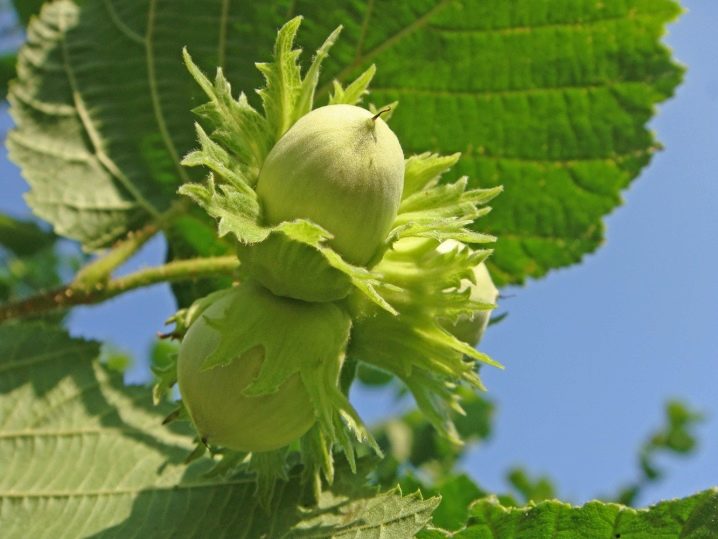
- "Masterpiece". Tall (up to 4 m) shrub, perfectly reproduces by root shoots and layering, not prone to thickening, begins to bear fruit from the third year. Productivity of the variety: up to 9 kg of large fruits from each bush. Pointed brown nuts are covered with a dark dense shell, have an excellent taste and a long shelf life - up to 1 year.
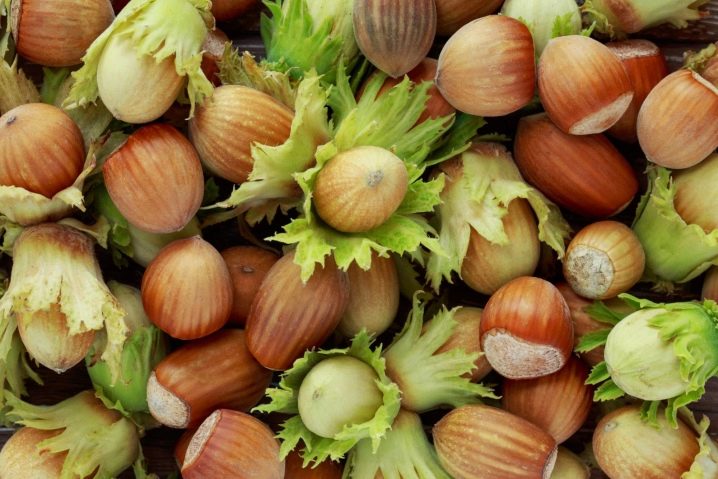
-
"Moscow Ruby". The predecessors of the variety were varieties of red-leaved hazelnuts. "Ruby" belongs to the late-ripening category. Decorativeness is provided by the power of the bush, height (up to 4.5 m), foliage of rich dark red shades and even a red plush. The yield is considered average - up to 4 kg per bush, but the variety gives a great large (3.5 g) nut of excellent taste with a well-felt sweetness. Fruit crops are large, from 7 to 15 nuts in one. The variety is distinguished by frost resistance (-40ºC), storage duration, and begins fruiting 5 years after planting.
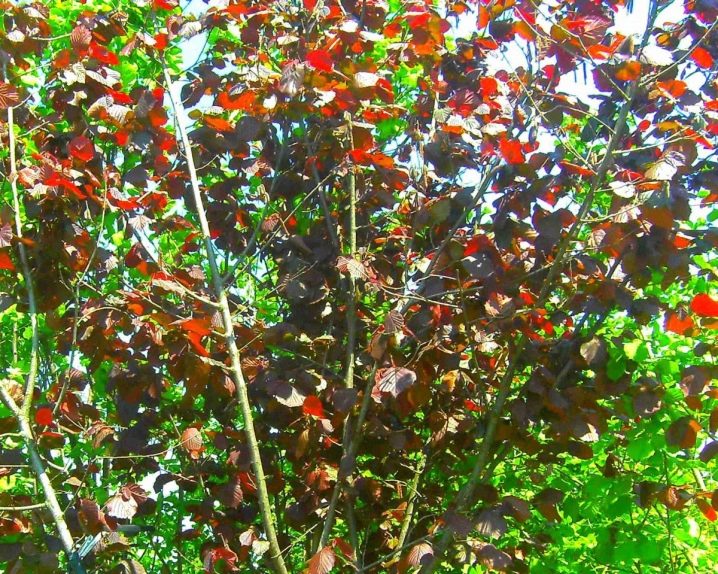
- "Catherine". Differs in high decorativeness, has large red foliage, plush with the same shades and a nut with a shell of raspberry-pink tones. The variety was obtained by the method of selection of crops from the hybrid fund of A.S. Yablokov. A powerful tall bush gives large (5 g) nuts with a thin shell and a dessert taste, collected in 8 fruit seedlings. The lack of the variety lies in the weak root system, which makes it problematic to grow "Ekaterina" in areas unprotected from strong winds. Weak winter hardiness allows its cultivation only in warm regions.
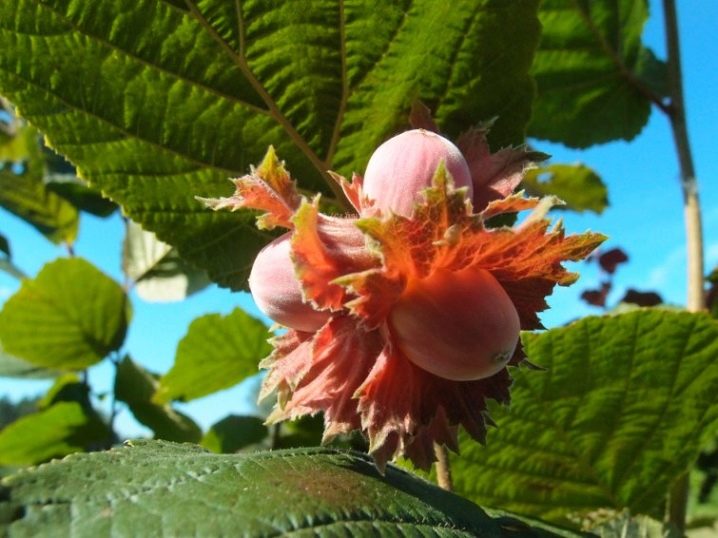
-
"North 42". A tall (up to 6 m) bush covered with bright green foliage, has high frost resistance, is suitable for industrial cultivation, gives high yields of tasty large (3.8 g) oblong nuts. Needs proximity to pollinating varieties.
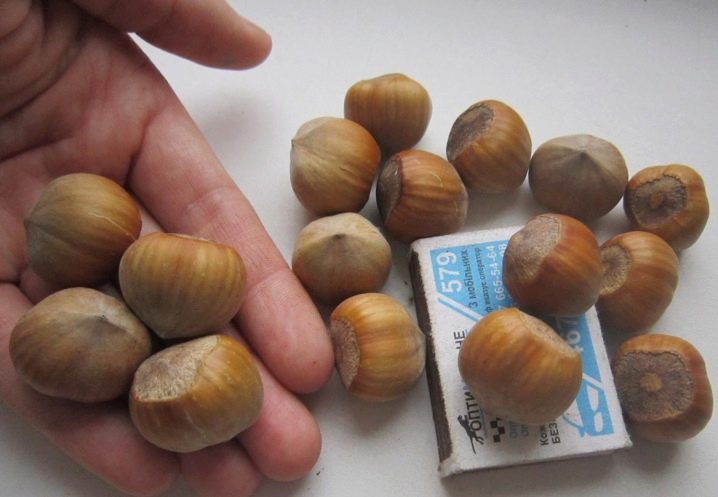
- Isaevsky. It is considered one of the most demanded representatives of the family. It appeared as a result of breeding work on crossing "Tambov" and red-leaved hazels. Shrub 1.5-2 meters high has excellent frost resistance (-40º and below), high yields and dessert taste.

- Barcelona. This variety is characterized by a dense crown, up to 5 meters high, large rounded foliage and early periods of entry into fruiting. Elongated nuts have an ovoid or conical shape, a strong reddish-brown shell and a pronounced sweetish dessert taste. Unfortunately, the variety is poorly resistant to a number of diseases and does not tolerate severe frosts.
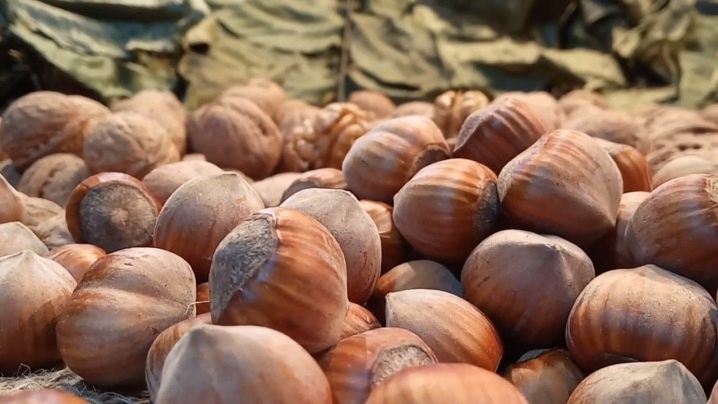
- "Adyghe 1". Hazel is considered universal, grown in the southern regions, widespread in the Caucasus and the Black Sea region. The multi-stemmed shrub has a dense spreading crown, strong immunity, a long lifespan - hazel can bear fruit for a century.Round nuts weighing up to 2 grams are collected in seedlings of 4-5 pieces, covered with a thin coffee-colored shell, have a pronounced sweet-tart dessert taste.
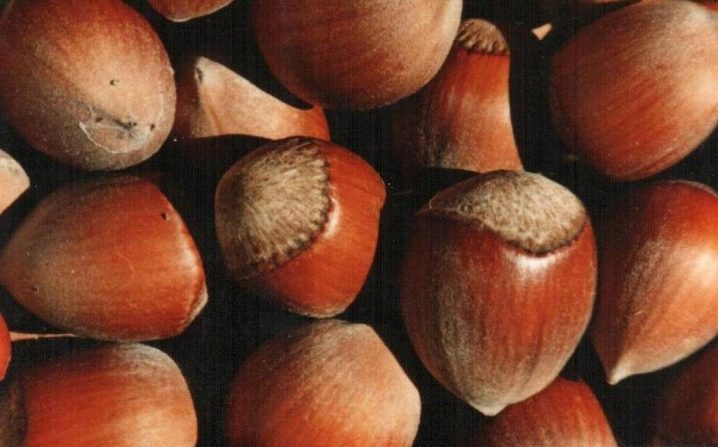
-
"Firstborn". Sprawling bushes covered with green foliage are up to three and a half meters high and reproduce with abundant root shoots. They are distinguished by high (up to 6 kg per bush) yields. Nuts weigh 2.5 g, collected in seedlings of 3-5 pcs., Covered with a light shell. The variety is characterized by high frost resistance: up to -40ºC.
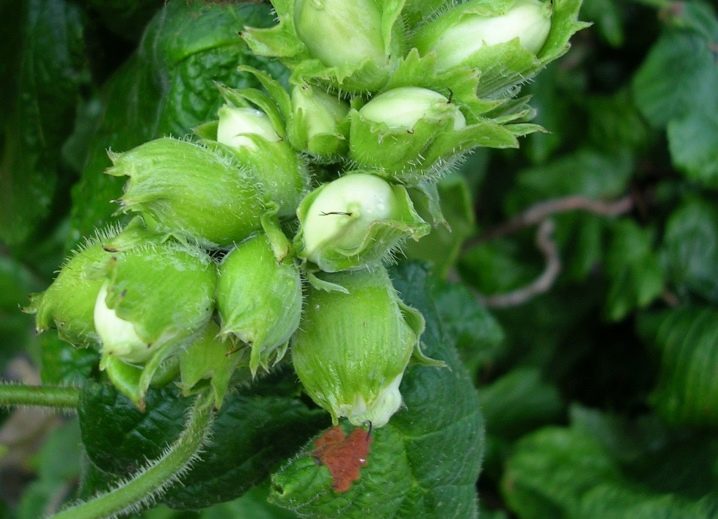
- "Maxima Purpurea" - a variety from the UK, where breeders bred it in 1836. Appearance: multi-stemmed shrub, spreading umbrella crown, height 4-5 m, strong straight shoots. The bark of the shoots is colored brown, the leaves are large (10-14 cm), painted purple, the hazelnut itself has a very pleasant gray tint.
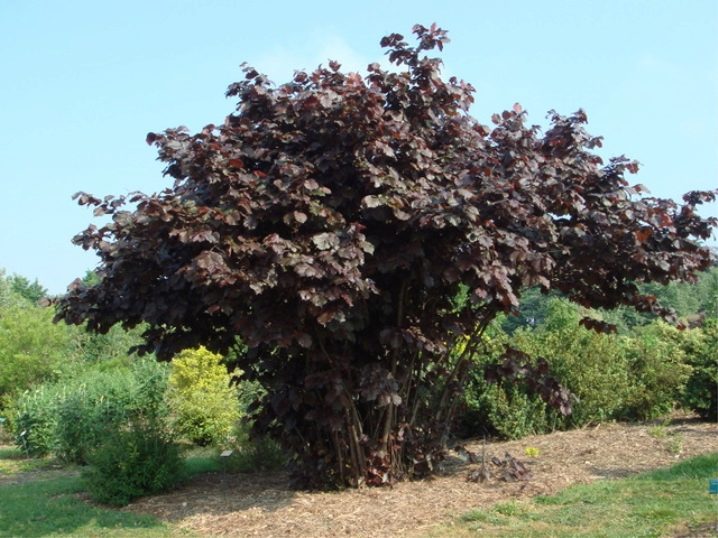
-
Red Majestic. A very beautiful shrub with a height of 3 to 5 meters and with a crown consisting of strongly curved, sometimes twisted shoots. It looks amazing, especially in early spring, when there is still no greenery, and the earrings are already hanging down. The foliage surface is painted in green tones.
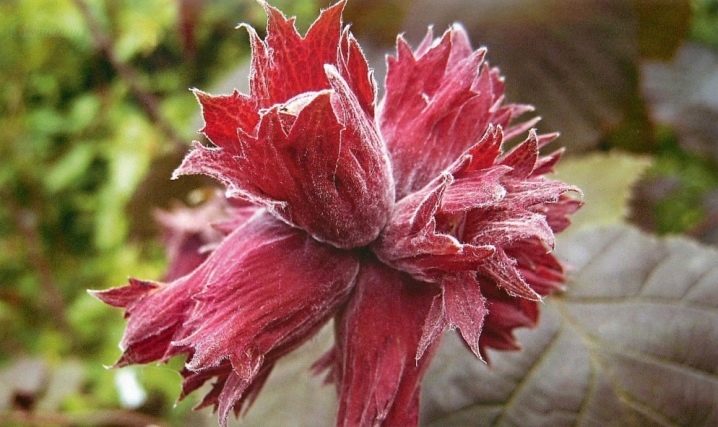
You can learn more about the varieties in the illustrated online atlas "Plantarium"... The purpose of the resource is for informational purposes, it is a plant guide intended for amateurs and professionals, where detailed characteristics of each crop are given.

Landing
It should be noted that domesticating hazel did not make her a loner - she still prefers group plantings... Almost all varieties need neighbors to improve the quality of pollination, which affects yield indicators. When planting several plants, keep a distance of 4-6 meters between the bushes. Overcrowding prevents the correct development of the hazel.
For planting, they choose places with a good level of illumination, protection from constant winds and drafts, in an open space - hazel does not like shading. It also reacts badly to the close occurrence of groundwater - the water layer should be located at least 1.5 m.
Before planting a group of plants, you should thoroughly dig up the entire area and only then dig holes.

For the birch family, soil fertility is of great importance - plants prefer neutral soils, rich in humus, with a high content of limestone. They love loose degraded and ordinary chernozem, gray oak, podzolic, alluvial soil, do not grow on peat and sandy soils.
-
Planting time is early spring or late autumn. In November, seedlings are transplanted into open ground about half a month before the onset of winter cold. Experts have noticed that this technique guarantees a high survival rate, because the sap flow has already stopped. Autumn transplanting is most preferable, since young animals need time to adapt, and the spring and summer heat makes this process difficult. The seedlings that survived the winter easily enter the growing season along with all the plants.
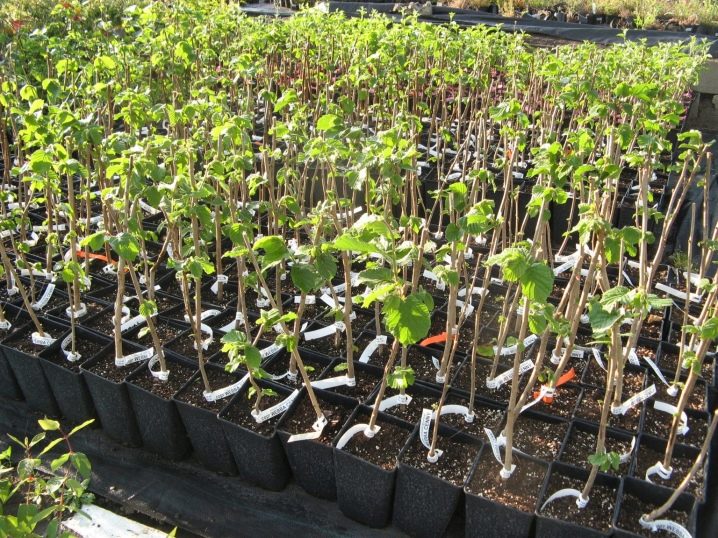
-
Landing... When buying planting material, you should pay attention to the condition of the seedling. It is advisable to choose specimens with ZKS, 3-4 well-developed shoots with a diameter of at least 1.5 cm.If a plant with ACS, then the length of its roots should be from 0.5 m.Immediately before planting, they are shortened to 25 cm. a month before the event. The optimal size of the planting pit:
-
on fertile soils - 50x50x50 cm;
-
on depleted soils - 80x80x80 cm.
-

The increased area allows high-quality filling of the excavation with nutrients. The removed soil is enriched with organic matter (humus, compost) at the rate of 1: 1, 200 grams of wood ash is added.
A drainage layer 15 cm high is arranged at the bottom. Then a hill is poured from a nutritious earth mixture, a seedling is placed at the top, covered with the remaining earth, compacting and making sure that no voids remain.
The near-trunk circle is watered with warm water, the next day it is mulched with peat or cut grass.

Care
The agrotechnology of growing hazel is not very difficult. If you sow green manures in the near-stem circle, then they further facilitate the work of the gardener, enriching, loosening the soil and saturating it with nitrogen.... After mowing, crops serve as an excellent mulch. Weeding removes nutritive rivals from hazelnut.

Watering
After planting and subsequent watering, the next one is carried out after 7 days. During the spring transshipment, young plants are watered 2 times a month if there is not enough natural precipitation, and once every 30 days - if there is rain.
Moisture is added at the rate of 20 liters per root. Adult hazel is watered in spring to improve vegetation, then 6 more times per season. During a drought, the frequency of irrigation is increased: once every 2 weeks.

Top dressing
The introduction of nutrients is carried out on a regular basis. Every 2 years in the fall, add 30 g of potassium salt, 50 g of superphosphate and humus. If sowing of siderates is not used, then in the spring the soil is enriched with urea or ammonium nitrate, which contributes to active vegetation.

Wintering
Adult hazel does not need winter protection. In the northern regions, the trunks of young animals up to three years old are wrapped with agrofibre or burlap, bent, if possible, to the ground and covered with spruce branches.
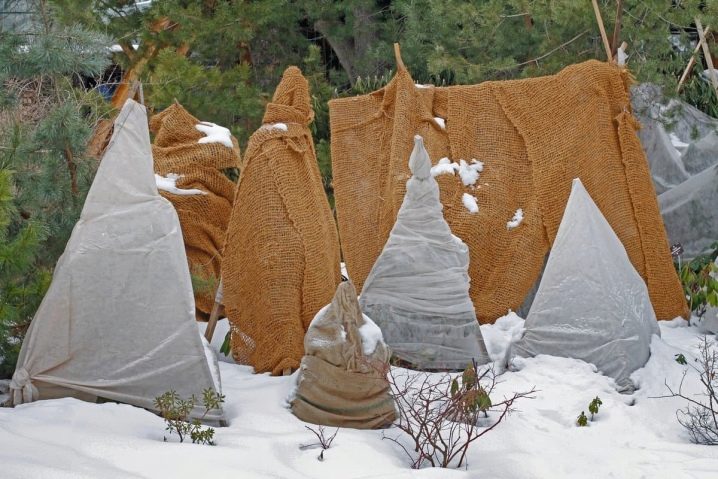
Pruning
Sanitary and formative pruning is done in the spring or fall. The first option should be carried out during flowering - disturbing the shoots, the gardener promotes more intense pollination.
During the first pruning, the branches are shortened by 20 cm. Subsequently, weak, deformed, dry shoots are removed, leaving 10 strong branches radially diverging from the roots.
At the age of 20, you can begin shrub rejuvenation procedures by replacing old trunks with young ones. Hazelnuts perfectly tolerate standard cultivation - the height of the stem is no more than 40-50 cm.
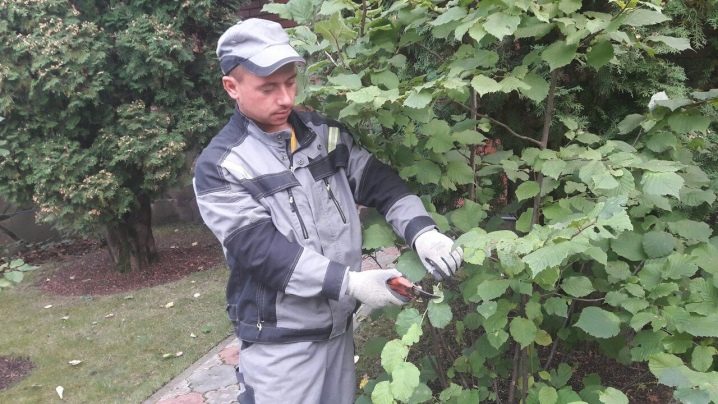
Reproduction
Common hazel is propagated by layering, root suckers, seeds and grafting. The sowing method is almost never practiced due to the existing simpler methods.
-
Root shoots... Young offspring can be removed at the age of two years. They are dug out, separated with a sharp instrument and transplanted, having previously processed the sections with crushed coal.
-
Layers only shrubs propagate. The lower annual branches are buried to a depth of 15 cm. The emerging vertical shoots are regularly spud and planted two years later.
-
Delenki... Bushes can be divided from the age of ten. They are dug up, divided into several parts and seated.
In order to propagate hazel by the grafting method, seedlings of wild or bear walnut are used as a stock, and cuttings of the desired variety are used as a scion.
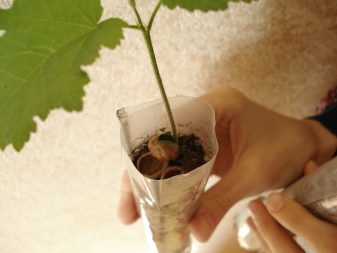
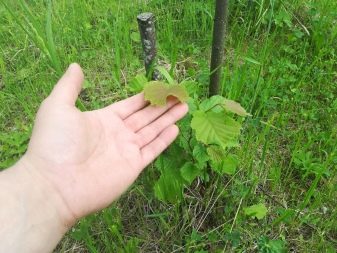
Diseases and pests
Despite strong immunity, hazelnuts can be affected by powdery mildew, rust and spotting. Of the pests that are dangerous for him:
-
kidney mite;
-
nut weevil;
-
hazelnut barbel;
-
nut leaf beetle.
To prevent and combat infections, insecticide and fungicide treatments are used.
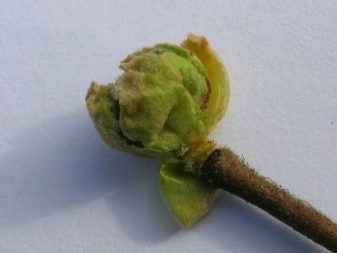
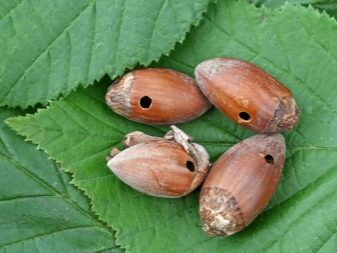









The comment was sent successfully.